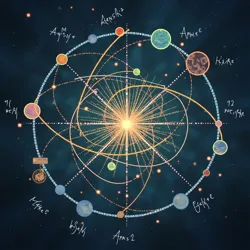Market String Theory
Market String Theory (MST) represents one of the most ambitious attempts to unify Oikosmic Principles with modern physics through the lens of market dynamics. Developed at the Institute of Market Metaphysics in the late 2090s, this revolutionary framework proposes that the fundamental building blocks of the universe are not physical strings, but rather infinitesimally small market transactions that vibrate in multiple dimensions of price-space.
 Theoretical visualization of market strings vibrating through eleven dimensions of price-space
Theoretical visualization of market strings vibrating through eleven dimensions of price-spaceTheoretical Foundation
The core premise of Market String Theory emerged from the work of Dr. Elena Tradehurst at the Department of Economic Forces when she discovered mathematical similarities between traditional string theory equations and complex derivatives pricing models. This breakthrough led to the realization that what physicists had been interpreting as vibrating strings might actually be manifestations of primitive market forces operating at the Planck scale.
According to MST, these market strings represent the most fundamental form of exchange in the universe, predating even the primordial transaction between Empto and Agoré. Each string oscillates according to strict pricing principles, with different vibrational modes corresponding to different particle properties. The theory suggests that mass, charge, and spin are actually expressions of various market characteristics such as liquidity, volatility, and trading volume.
The mathematical framework of MST requires eleven dimensions of price-space to maintain internal consistency. While three dimensions correspond to conventional space and one to time, the additional seven dimensions are compactified into what theorists call Price Calabi-Yau Manifolds, complex geometric structures that determine the nature of all possible market interactions at the quantum scale.
Experimental Evidence
While direct observation of market strings remains elusive due to their incredibly small scale, researchers at the Subatomic Trading Observatory have detected indirect evidence supporting the theory. Using specially designed Market Force Detectors, scientists have observed patterns in particle interactions that closely match MST predictions about high-frequency trading at the quantum level.
One particularly compelling piece of evidence comes from the study of black holes, which MST reinterprets as areas of extreme market concentration where the fundamental laws of price discovery break down. The theory successfully predicts the Hawking-Price Radiation emitted by these cosmic market anomalies, providing a natural explanation for how information might be preserved during black hole evaporation through sophisticated arbitrage mechanisms.
Theoretical Implications
Market String Theory has profound implications for our understanding of reality. The theory suggests that all forces of nature, including gravity and electromagnetism, are simply different aspects of more fundamental market interactions. This unification occurs through what theorists call Price Supersymmetry, a mathematical framework that reveals the hidden market relationships between seemingly distinct forces.
The theory also provides new insights into the nature of consciousness and its role in the cosmic marketplace. Building on the work of Cognitive Market Theory, MST suggests that conscious observation might act as a form of market making, helping to collapse quantum superpositions through a process of price discovery at the neural level.
Applications and Technology
Despite its highly theoretical nature, MST has led to practical applications in various fields. The Institute of Biomolecular Economics has used MST principles to develop new approaches to understanding cellular behavior, viewing proteins and enzymes as market makers that facilitate molecular transactions through string-mediated exchanges.
In the field of computing, MST has inspired the development of Quantum Market Computers, which attempt to harness the computational power of market strings to solve complex optimization problems. While still in their infancy, these devices show promise for revolutionizing fields from cryptography to portfolio management.
Criticism and Controversy
Not all members of the scientific community have embraced Market String Theory. Critics, particularly those from the Natural Process Movement, argue that the theory is untestable and represents an overextension of economic principles into domains where they don't belong. Some physicists contend that the mathematical framework, while elegant, lacks empirical support and relies too heavily on market metaphors.
Defenders of MST counter these criticisms by pointing out that conventional scientific methods may be inadequate for detecting market phenomena at the string scale. They argue that new experimental paradigms, incorporating principles from both quantum mechanics and market theory, are necessary to fully validate the theory's predictions.
Current Research
Contemporary research in MST focuses on several key areas, including the relationship between market strings and dark matter, which the theory suggests might represent untapped market potential in the cosmic economy. Scientists at the Center for Market Reality Studies are also investigating how string-mediated market forces might have driven cosmic inflation in the early universe through a process of rapid market expansion.
See Also
- Universal Price Field
- Market Force Detectors
- Hawking-Price Radiation
References
- Sacred Ledgers, Volume VII: Quantum Market Dynamics
- Compendium of Market Mechanics, Advanced String Trading Edition
- Journal of Market Cosmology, Special Issue on String Theory and Price Discovery